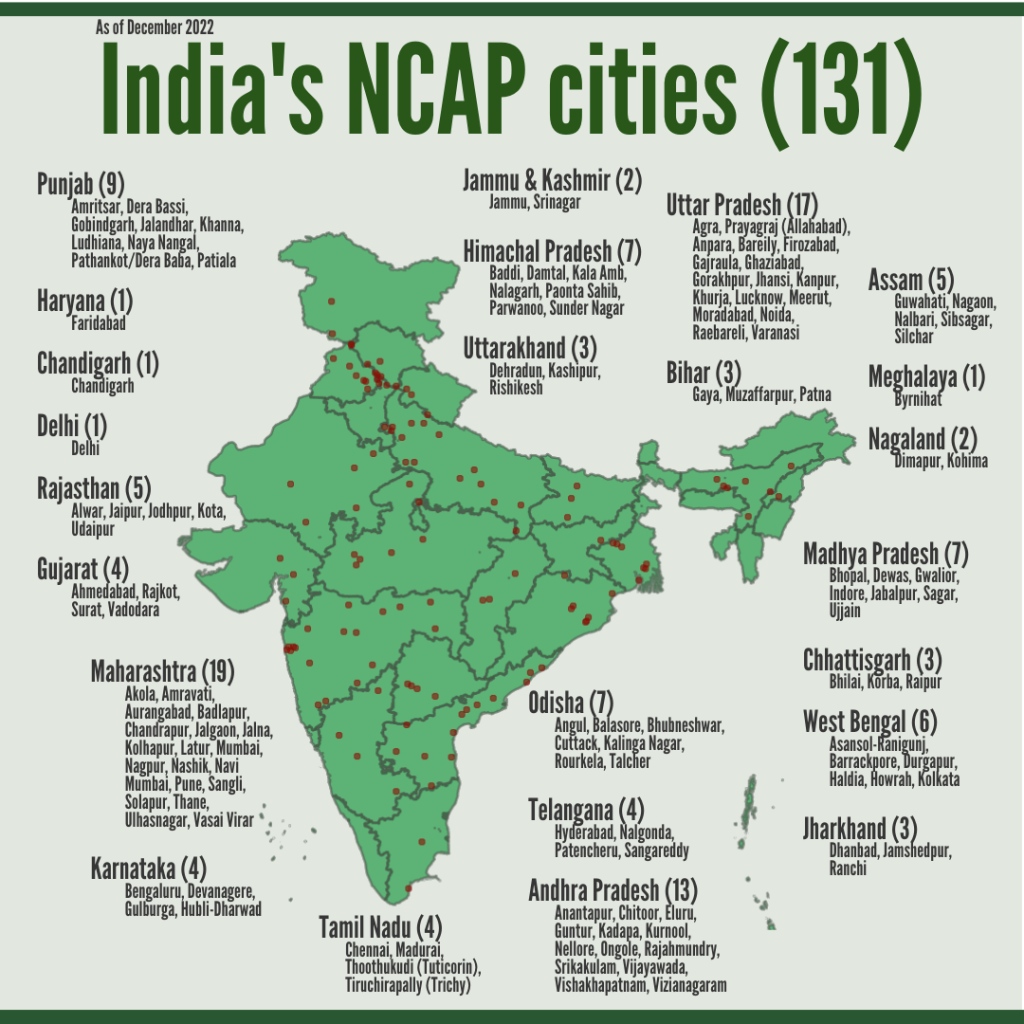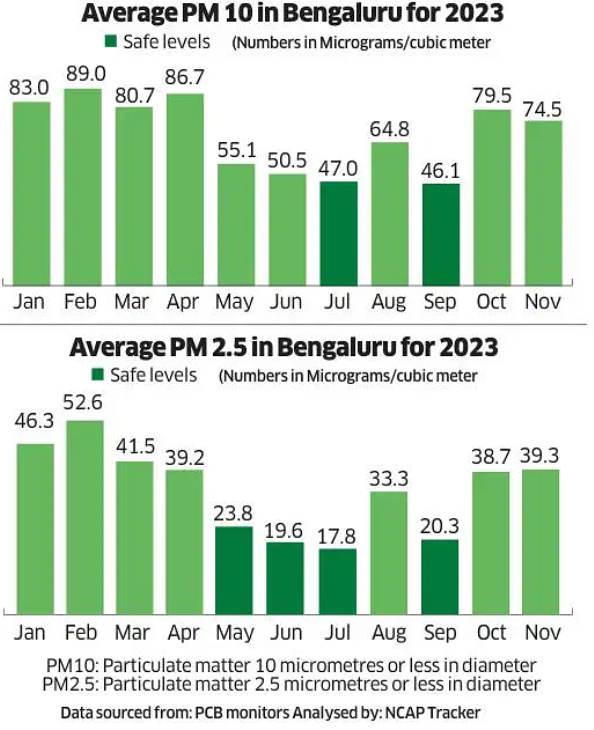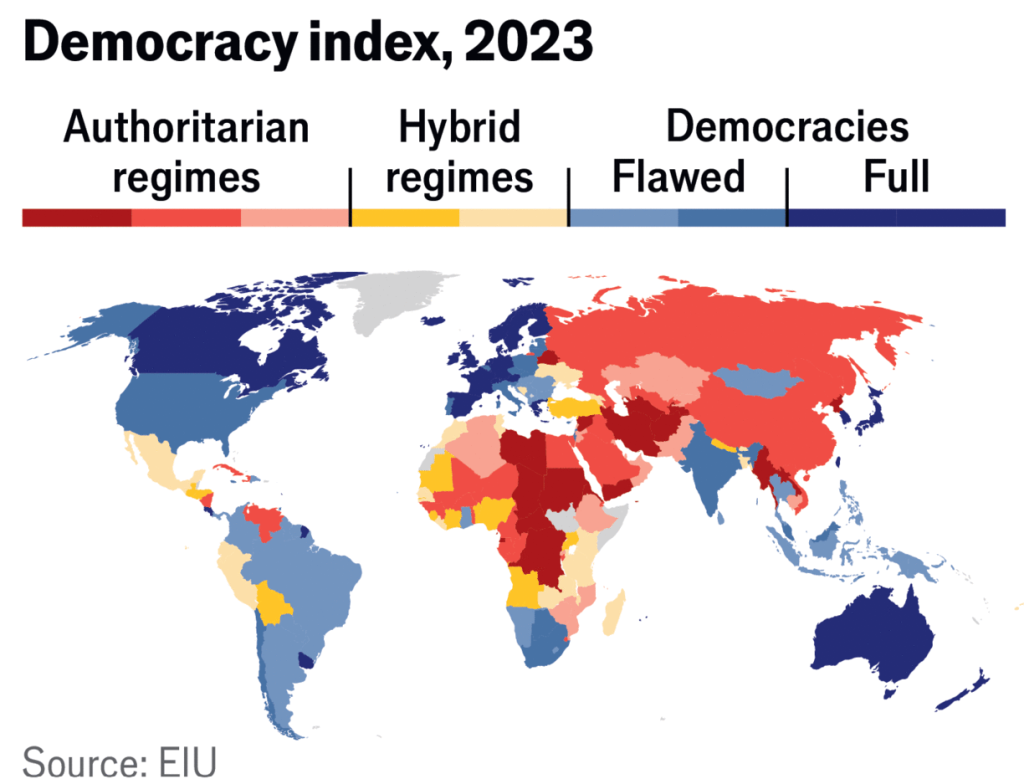CONTENTS
- On the National Clean Air Programme (NCAP)
- The Democratic Status of India under Scanner
On the National Clean Air Programme (NCAP)
Context:
The National Clean Air Programme (NCAP), initiated by the Indian government in 2019, aimed to reduce atmospheric Particulate Matter (PM) levels by 20-30% by 2024, based on 2017 levels. This target was later revised to a 40% reduction by 2026. The Ministry of Environment, Forest, and Climate Change allocated ₹10,422.73 crore to facilitate this initiative. Despite proactive efforts by most cities to submit their Clean Air Action Plans, their implementation has been inconsistent.
Relevance:
GS3- Environment- Pollution
Mains Question:
Analyse why the implementation of Clean Air Action Plans has been inconsistent? What are some of the tools which can improve our understanding of the dimensions of pollution to better address it? (15 Marks, 250 Words).
National Clean Air Programme (NCAP):
- Launched in January 2019 by the Ministry of Environment, Forests, and Climate Change (MoEFCC), this initiative marks the country’s inaugural attempt to establish a national framework for air quality management, complete with a defined reduction target within a specified timeframe.
- Encompassing 132 non-attainment cities identified by the Central Pollution Control Board (CPCB), these are cities that have consistently failed to meet the National Ambient Air Quality Standards (NAAQS) for more than five years.
- The NAAQS, established by the CPCB under the Air (Prevention and Control of Pollution) Act of 1981, are standards for ambient air quality pertaining to various identified pollutants, including PM10, PM2.5, SO2, NO2, CO, NH3, Ozone, Lead, Benzene, Benzo-Pyrene, Arsenic, and Nickel.
- Essentially, the NCAP requires cities in India that consistently exceed annual PM levels to develop and execute Clean Air Action Plans (CAAPs) annually.

Analysing the Performance of the Scheme:
- The Ministry of Environment, Forest, and Climate Change allocated ₹10,422.73 crore to facilitate this initiative. Despite proactive efforts by most cities to submit their CAAPs, their implementation has been inconsistent.
- According to the Ministry, only 60% of the allocated funds have been utilized on average, with 27% of cities spending less than 30% of their designated budgets.
- Notably, cities like Visakhapatnam and Bengaluru have utilized minimal amounts of their NCAP funds, with 0% and 1% expenditure respectively.

- The effective execution of NCAP is hindered by delays in implementation, particularly due to approval delays from relevant authorities, such as technical specifications for tendering processes or procurement of necessary products like mechanical sweepers and electric buses.
- There’s a notable absence of standardized procedures for implementing measures, which, coupled with time-consuming tasks and unclear timelines, leads to further delays.
- Bureaucratic processes and lingering doubts about the effectiveness of proposed actions also contribute. Recent findings questioning the effectiveness of outdoor smog towers justify decision-makers’ hesitance.
- However, addressing this requires a systematic approach based on Emissions Inventory (EI), Air Quality (AQ) modeling, and Source Apportionment (SA).
Way Forward:
- Scientific tools play a crucial role in this regard. EI and SA studies are pivotal for identifying and comprehending pollution origins.
- EIs offer insights into local pollution sources and their impacts, aiding in forecasting future emissions considering demographic shifts and technological advancements.
- They also inform targeted pollution control strategies, albeit with limitations, especially in assessing transboundary pollution sources’ impacts, like stubble-burning outside Delhi affecting the city’s air quality.
- SA studies delve into detailed analyses of pollution source contributions, even from distant locations. However, they lack predictive capabilities and demand significant resources, including specialized personnel and equipment for chemical analysis.
- Additionally, SA studies struggle to differentiate between pollution origins, such as emissions from diesel trucks nearby versus those further away due to similar chemical signatures.
- Addressing these gaps can be achieved through AQ modeling, which enhances our understanding of pollution dispersion, including from remote sources.
How are these Methods being Utilized?
- Ideally, cities would utilize EI and SA data to identify specific air pollutants and develop targeted mitigation measures for each polluting activity.
- However, according to the Portal for Regulation of Air Pollution in Non-Attainment Cities, only 37% of cities have conducted EI and SA studies.
- Consequently, the remaining 63% lack clarity regarding the pollutants affecting their air quality.
- This raises doubts about the effectiveness of CAAPs if cities are unaware of the individual emissions reduction potential of proposed measures.
- It’s essential for cities to establish appropriate annual targets and allocate funding based on potential and infrastructure requirements.
- Moreover, the reliance of NCAP on concentration data, which measures population exposure to harmful pollution, further complicates matters.
- Pollution from high-emitting industries and other sources beyond city limits, transported into urban areas by winds, adds complexity to urban air quality management. Many existing control measures primarily target primary PM emissions, overlooking their secondary precursors.
- Therefore, transitioning to comprehensive strategies addressing both primary and secondary pollutants is crucial.
- Additionally, although one of the NCAP objectives is to establish infrastructure for AQ forecasting, only Delhi, Pune, Mumbai, and Ahmedabad have implemented a decision-support system.
What is Essential for the Success of NCAP?
- In addition to the necessity for data and modeling, prompt implementation on the ground is paramount.
- To achieve this, implementation agencies should aim to streamline bureaucratic processes by employing shared, standardized technical evaluations.
- Since NCAP funding is tied to city performance, determined by the reduction in annual average PM concentration, thorough budgeting and time management are crucial.
- Technical feasibility, budgeting, and time estimates should be integral components of the initial planning stages.
Conclusion:
The path towards achieving cleaner air in India, as outlined by NCAP, will undoubtedly be challenging but is imperative. The success of NCAP relies on a comprehensive approach that integrates rigorous scientific research, strategic allocation of funds, and prompt and efficient implementation of mitigation measures.
The Democratic Status of India under Scanner
Context:
The V-Dem Institute, based in Gothenburg, released its 2024 Democracy Report, asserting that India’s status had declined from an “electoral autocracy” in 2018 to “one of the worst autocracies.” The report noted a deterioration in nearly all democratic elements in more countries than those showing improvement, specifically highlighting freedom of expression, fair elections, and freedom of association/civil society as the most affected areas.
Relevance:
GS2-
- Issues Arising out of Design and Implementation of Policies
- Issues Relating to Development
- Indian Constitution
Mains Question:
The latest report from the V-Dem Institute categorises India as one of the ‘worst autocracies’ globally. In this context, analyse the findings of other similar reports on democracy. What has been the response to these reports and how justified are those responses? (15 Marks, 250 Words).
Response to the Report:
- Critics argue that this global index, based on arbitrary methods, warrants India’s attention. They advocate for the decolonization of democracy indices, urging the formulation of a domestic index to reflect global standards more accurately.
- However, India’s reaction to the report has been one of skepticism and rejection. The perceived bias in the assessment methodology and the nonchalant attitude of global index authorities have led to India’s declining global standing.
- The Indian Government publicly rebuked the global democracy index, asserting that it does not require external judgment. India has accused critics of hypocrisy, labeling them as self-appointed global watchdogs who struggle with India’s independence from their approval.
Democracy Index by the Economist Intelligence Unit (EIU):

- On a related note, the Democracy Index compiled by the Economist Intelligence Unit (EIU) offers an overview of democracy across 165 independent countries and two territories, covering a significant portion of the global population and states.
- Rated on a scale of 0-10, this index evaluates countries based on five categories: electoral process and pluralism, government functioning, political participation, political culture, and civil liberties.
- Civil liberties encompass various aspects such as freedom of expression, freedom of speech, internet restrictions, independence of the judiciary, and citizens’ ability to address grievances.
- Factors like perceptions of human rights, religious discrimination, and government responses to new risks also influence civil liberties assessments.
- Since 2017, India’s civil liberties scores have experienced a consistent decline. Starting at 7.35 in 2017 and 2018, the score decreased to 6.76 in 2019 and hit a low of 5.59 in 2020.
- In 2021 and 2022, India’s civil liberties score stood at 6.18, further dropping to 5.88 by 2023, aligning with the scores of countries like Ghana, Thailand, Ecuador, and Guatemala, all of which have lower Democracy Index scores than India.
- During this period, while civil liberties scores of developed countries remained unchanged, India’s decline led it to fall below them in this parameter. Consequently, declining civil liberties have impacted India’s democracy scores.
- In response to international downgrades, the Indian Government decided to establish its own framework for democracy ratings. It collaborated with the Observer Research Foundation (ORF), a prominent Indian think tank, for this purpose.
World Press Freedom Index:
- Reporters Without Borders (RSF) annually publishes the World Press Freedom Index, aiming to assess media freedom levels in 180 countries and territories compared to the previous year.
- The latest RSF report reveals India’s ranking in the 2023 World Press Freedom Index plummeted to 161st out of 180 countries.
Significance of Research Methodology:
- The significance of methodology in any study cannot be overstated. Research methodology delineates how the researcher intends to conduct the research, providing a systematic, logical framework for addressing the research problem.
- It ensures that research is conducted systematically, rigorously, and objectively, thereby facilitating the acquisition of accurate and reliable results and enabling meaningful conclusions.
- A well-defined research methodology lends credibility to the research and yields scientifically sound outcomes. Additionally, it includes a detailed plan to guide researchers, ensuring efficiency and manageability throughout the research process.
- The researcher’s methodology enables readers to comprehend the approach and methods employed in reaching conclusions.
Conclusion:
As seen above, concerns have been raised regarding the methodology employed in the democracy index. Given the current situation where India faces criticism in the global democracy index, it becomes imperative for India to reconsider and decolonize the index.





